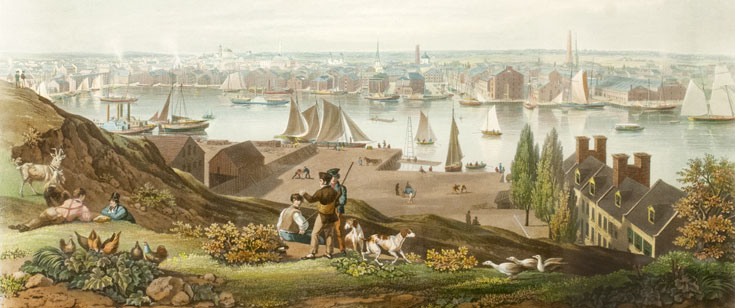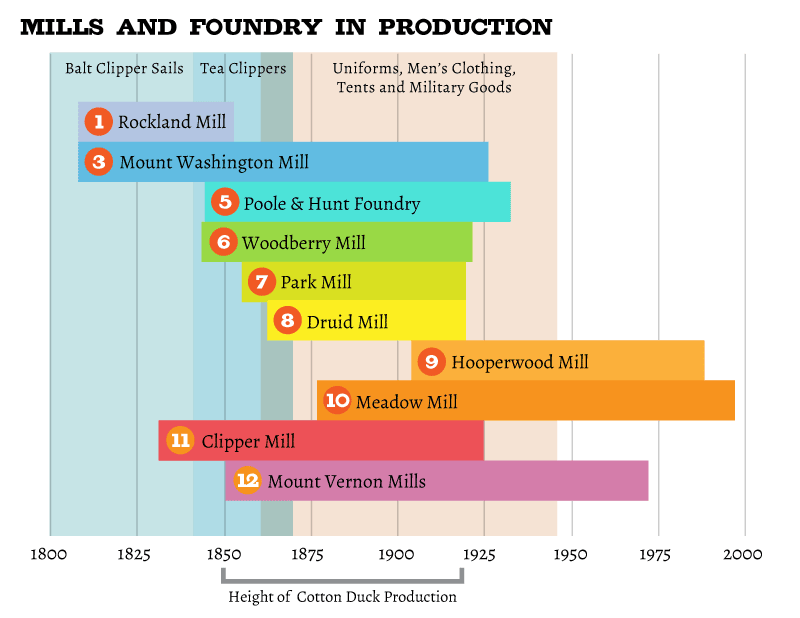
Cotton Mills of the Jones Falls

Portion of lithograph of "Baltimore from Federal Hill, 1831," by William James Bennett, collection of the University of Baltimore
Early Mill History of Baltimore
Maryland's colonial General Assembly authorized the Port of Baltimore in 1706 and the town of Baltimore in 1723. Baltimore was originally intended as a tobacco port, but there were two problems: the land around Baltimore was ill-suited for growing tobacco, and tobacco growers on the Eastern and Western Shores of the Chesapeake Bay had easy access to docks much closer to them. So the port grew very slowly.
Grist Mills
Through the early 1700s German and Scots-Irish farmers from Philadelphia, who were adept at growing corn and wheat, moved into southern Pennsylvania and northern Maryland. Baltimore was their nearest port, and the rivers they passed on their way to the harbor — the Jones Falls but also the Patapsco and Gunpowder rivers — were ideal for generating the water power necessary to run mills to grind grain into flour for shipping elsewhere in the Colonies (Olson 5).
As the Jones Falls flowed between Rockland, Maryland, near the top of Falls Road, and the harbor, the river dropped 259 feet as it passed from the highlands to the coastal plain. The current in the two-mile stretch through what is today Hampden-Woodberry was particularly strong for turning mill wheels (Beirne 7).
In 1750, John Stevenson, an Irish-born physician, shipped a cargo of flour back to Ireland as an experiment. It was well received, both for its quality and its resistance to mold. This was the start of Baltimore's flour export business (Keith 6). In the late 18th and early 19th centuries, Baltimore had some additional strokes of luck:
- During the Revolutionary War, Spanish colonies in the Caribbean opened their ports to American shipping, and Baltimore flour had a slight price advantage over New York and Philadelphia flour
- flour prices in Europe rose steadily during the Napoleonic wars (1804–1815), and after the War of 1812, the British armies bought huge quantities of flour from the Americans for their troops (Gilbert 250)
- and fast Baltimore Clipper ships found additional markets for grain in South America.
By 1810, Baltimore had become a world center for flour milling.
Because of it's value as a port, the developing of its shipbuilding industry, and European immigration into the port, Baltimore became the first boom town in the United States, almost doubling in size every ten years between the Revolutionary War and 1810 (Slayden). In 1800, it became the third largest city in the U.S. after New York and Philadelphia.
Competition for grist milling became fierce along the Jones Falls; at one point, there were as many as 12 grist mills within four miles of Baltimore (Beirne 7).
Cotton Mills
In the late 1700s, cotton goods, originally imported from India, became fashionable because of their low cost and good looks. And due to advances in British methods of manufacturing cotton (see Automation), Great Britain was fast becoming the world leader in manufacturing cotton goods. Americans liked cotton goods, and merchants looked for ways of producing them here. The first American mill to complete with the British was Slater's Mill, a spinning mill built in 1793 in Pawtucket, Rhode Island by Samuel Slater, and expatriated Englishman with knowledge of mills.
Then, in 1807, President Thomas Jefferson imposed an embargo on British-produced goods in retaliation for British seizing American sailors on the high seas and forcing them to sail their ships. This embargo was unpopular because the United States was so reliant on manufactured items from Great Britain. But a result was to spur the growth of home-grown industries.
The first cotton mill in Maryland — the Mount Washington Mill — was built in 1810. By August, the Mount Washington Mill had 1,000 spindles, seven looms (probably hand operated looms, as power looms were not widely used before 1815), and a dye house. Though the mill was underutilized, and wouldn’t become successful until purchased by Horatio Gambrill and David Carroll in 1853, it was the start of cotton milling on the Jones Falls (Shoken).
"Rapid residential development along Jones Falls outside Baltimore City actually began in 1839 when David Carroll and Horatio Gambrill purchased the Whitehall property and built the Whitehall Cotton Factory. With five looms they began the manufacture of cotton duck (canvas) for sails. Three years later, they purchased property in Woodberry and built the Woodberry factory. At this same time clusters of stone, workers’ houses sprang up adjacent to the mills. These mill hamlets later grew into villages—villages that by the end of the century merged into the urban community of Hampden-Woodberry." (Beirne 7)
The mill owners in Baltimore had several advantages: 1) they were close to the Southern cotton fields, and Marylanders were considered Southerners; 2) they were located right next to a busy trading and shipbuilding port, where there was a ready market for their sail cloth; 3) The new Baltimore & Ohio (B&O) Railroad ran through the coal fields of West Virginia, bringing cheap coal right to the harbor; 4) And rail service to Philadelphia, New Jersey and New York was inexpensive, allowing for further sales of their goods.
As late as 1853, cotton duck from Baltimore mills was considered inferior to cotton duck from New Jersey, their chief competitor. According to DeBow’s Review, 1853, “There are also quantities of cotton duck made in New England, Maryland, &c.; but the article produced by Mr. Colt (John Colt, Paterson, N.J.) has always maintained its superiority, and commanded the highest price in the market” (DeBow 480). But with improvements in spinning and weaving machines, cheaper labor, and better access to the Southern cotton market, Baltimore soon pulled ahead.

Chart showing the dates the mills and foundry were in production, the mills’ principal clients, and the period of greatest production.
Cotton Boom, 1850-1920
Initially, local cotton mills supplied sails for the Tea Clippers that raced across the Pacific and around Cape Horn to bring back the freshest tea from China. As clipper ships were replaced by steamships in the 1870s, the cotton mills supplied sails for the Chesapeake Bay oyster boom. As that waned, Baltimore became known for making clothing — particularly uniforms — and military items such as tents and backpacks for the Spanish-American War and World War 1 (Jensen).
In the late 1800s, the mills of the Jones Falls, through low prices and excellent quality, had 70% of the cotton duck market in the United States. In 1872 the mills sold about $3 million in goods; this would be equivalent to $58.6 million in 2013 dollars. (“The Industrial Interests”)
In 1895, the mill owners considered consolidating to corner the duck market, as was being done in many other large industries at the time. Nothing came of it. But in 1898 this consolidation was proposed, not by the mill owners, but by John H. Parks, a New York promoter. Backing him was the J. Spencer Turner Company, a prominent commission house — a brokerage which buys and sells futures contracts — and other New York capitalists. Mt. Vernon Mills, Woodberry Manufacturing Company, and four Southern mills consolidated into Mount Vernon-Woodberry Cotton Duck Company in 1899 (Bullock 10).
James E. Hooper quickly became disillusioned with the trust and broke away, building Hooperwood in 1904, the first fully-electrified mill and the last new mill built in the Jones Falls Valley.
Meanwhile, though the cotton duck trust started with 80% of the cotton duck market in 1905, by 1909 it only had 60% of the market.
Strike and Decline, 1927-1982
World War 1 brought a spectacular boom to the mills. War demand for cotton duck brought more jobs, longer hours, and higher wages. One family reported an astonishing total earnings of $75.00 per week ($1,600 a week in 2013 dollars). With this new situation came higher expectations among many workers, who struck for higher pay. Owner's profits were high enough that they conceded to workers' demands. Strikes all over the country increased from 1,405 in 1915 to 4,359 in 1917 (Harvey 32).
Following World War 1 textile manufacturers were hard-pressed. Wartime demand had dropped off, cotton prices were down, there was more competition from both the Southern mills and mills in Asia, and owners in Baltimore faced an expanded workforce that was used to getting what they wanted (Beirne 18, Harvey 36).
“The strike against Mount Vernon-Woodberry Mills in 1923 was the end of the strikes and the cotton mills in Hampden-Woodberry. Almost a thousand workers struck; the owners refused to back down or negotiate. Eventually the workers returned to work. But by 1925 the mill owners sold off the workers’ housing. Three mill buildings were sold, from which operations were moved south to Tallassee, Alabama and Greenville, South Carolina.” (Harvey 37)
In contrast, Hooperwood had a solid business — U.S. Government contracts, making circus tents for the Barnum & Bailey Circus, and weaving drying felts for paper mills — with no labor unrest (Beirne 18). Mt Vernon Mills #1, #2 and #3 and Hooperwood were the sole surviving mills after the 1920s.
Both Hooperwood and Mt. Vernon Mills reached full capacity weaving cotton duck for the military in World War II, but production dropped off precipitously with the end of the war. Mount Vernon Mills converted to weaving synthetics in the 1960s and continued until it closed in 1972 (McGrain 597–599). Hooperwood created specialized product lines, but their output steadily decreased until the company was sold in 1988 (Hooper).